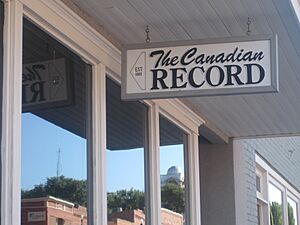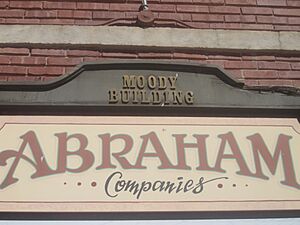Hemphill County, Texas facts for kids
Quick facts for kids
Hemphill County
|
|
|---|---|
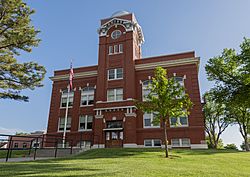
Hemphill County Courthouse in Canadian
|
|
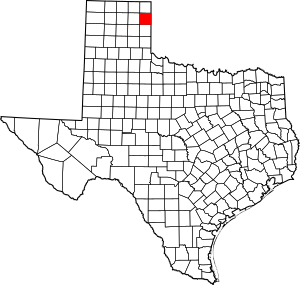
Location within the U.S. state of Texas
|
|
 Texas's location within the U.S. |
|
| Country | |
| State | |
| Founded | 1887 |
| Named for | John Hemphill |
| Seat | Canadian |
| Largest city | Canadian |
| Area | |
| • Total | 912 sq mi (2,360 km2) |
| • Land | 906 sq mi (2,350 km2) |
| • Water | 5.9 sq mi (15 km2) 0.6% |
| Population
(2020)
|
|
| • Total | 3,382 |
| • Density | 3.7083/sq mi (1.4318/km2) |
| Time zone | UTC−6 (Central) |
| • Summer (DST) | UTC−5 (CDT) |
| Congressional district | 13th |
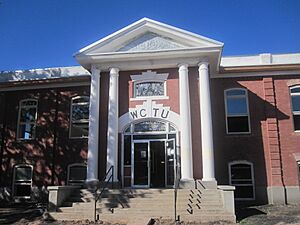
Hemphill County is a county located in the U.S. state of Texas. It is found in the northern part of Texas, known as the Panhandle. In 2020, about 3,382 people lived there. The main town and only official community is Canadian, which is also the county seat.
Hemphill County was created in 1876 and officially organized in 1887. It is named after John Hemphill, who was an important judge and a politician during the Confederate period. Hemphill County was the last county in Texas to allow alcohol sales.
Contents
History of Hemphill County
Early Days
For about 200 years before 1875, different Native American tribes, like the Apache, Comanche, and Kiowa, lived in the Texas Panhandle. They followed the large herds of bison (also called buffalo) that roamed the area.
In the 1840s, explorers like Josiah Gregg and Captain Randolph B. Marcy mapped trails through Hemphill County. They were looking for new routes to California and Santa Fe, New Mexico. Their trails followed the south side of the Canadian River.
A big conflict called the Red River War happened in 1874–75. The United States Army wanted to move the Native American tribes of the Southern Plains to Indian Territory, which is now Oklahoma. Two important battles, the Battle of Lyman's Wagon Train and the Battle of Buffalo Wallow, took place in what would become Hemphill County.
On April 12, 1879, Wheeler County became the first organized county in the Panhandle. Hemphill County was one of 14 other areas connected to it. Hemphill County officially became its own organized county in July 1887.
The Santa Fe Railroad Arrives
In 1886, a railway company called Southern Kansas Railway, which was part of the Santa Fe system, started building train tracks into the Texas Panhandle. The tracks reached Hemphill County in 1887. This helped more people settle in the area and led to the creation of three towns: Mendota, Canadian, and Glazier.
In 1907, Canadian became a "division point" for the Santa Fe railway. This meant it was an important stop where trains could be serviced and crews could change. This brought many new jobs and different types of businesses to the area, which had mostly been about ranching before. The Santa Fe railway was very important to Hemphill County until the mid-1950s, when the railway moved its employees to Amarillo.
Hemphill County was also located roughly in the middle of two smaller railway lines: the Clinton and Oklahoma Western Railroad Company and the Clinton-Oklahoma-Western Railroad Company of Texas.
Oil Production Growth
During the 1970s, Hemphill County grew a lot because of a big increase in oil production. Oil was first found in the county in 1955, but it was hard to get out of the ground because it was very deep. As technology improved, it became easier to get the oil.
By 1974, the county was producing about 999,000 barrels of oil. By 1978, this number grew to more than 1,891,000 barrels. In 2000, about 505,000 barrels of oil and more than 8 billion cubic feet of natural gas were produced. The future for oil and gas in the county looked very promising.
Geography
Hemphill County covers a total area of 912 square miles. Most of this area, about 906 square miles, is land. The remaining 5.9 square miles (0.6%) is covered by water.
Main Roads
Neighboring Counties
- Lipscomb County (north)
- Ellis County, Oklahoma (northeast)
- Roger Mills County, Oklahoma (southeast)
- Wheeler County (south)
- Roberts County (west)
- Gray County (southwest)
Protected Areas
- Black Kettle National Grassland (part of this protected area is in Hemphill County)
Population Information
| Historical population | |||
|---|---|---|---|
| Census | Pop. | %± | |
| 1880 | 149 | — | |
| 1890 | 519 | 248.3% | |
| 1900 | 815 | 57.0% | |
| 1910 | 3,170 | 289.0% | |
| 1920 | 4,280 | 35.0% | |
| 1930 | 4,637 | 8.3% | |
| 1940 | 4,170 | −10.1% | |
| 1950 | 4,123 | −1.1% | |
| 1960 | 3,185 | −22.8% | |
| 1970 | 3,084 | −3.2% | |
| 1980 | 5,304 | 72.0% | |
| 1990 | 3,720 | −29.9% | |
| 2000 | 3,351 | −9.9% | |
| 2010 | 3,807 | 13.6% | |
| 2020 | 3,382 | −11.2% | |
| U.S. Decennial Census 1850–2010 2010 2020 |
|||
| Race / Ethnicity (NH = Not Hispanic) | Pop 2000 | Pop 2010 | Pop 2020 | % 2000 | % 2010 | % 2020 |
|---|---|---|---|---|---|---|
| White alone (NH) | 2,722 | 2,656 | 2,090 | 81.23% | 69.77% | 61.80% |
| Black or African American alone (NH) | 52 | 4 | 4 | 1.55% | 0.11% | 0.12% |
| Native American alone (NH) | 22 | 12 | 18 | 0.66% | 0.32% | 0.53% |
| Asian alone (NH) | 9 | 18 | 10 | 0.27% | 0.47% | 0.30% |
| Pacific Islander alone (NH) | 1 | 3 | 0 | 0.03% | 0.08% | 0.00% |
| Other race alone (NH) | 5 | 0 | 4 | 0.15% | 0.00% | 0.12% |
| Mixed race (NH) | 18 | 28 | 119 | 0.54% | 0.74% | 3.52% |
| Hispanic or Latino (any race) | 522 | 1,086 | 1,137 | 15.58% | 28.53% | 33.62% |
| Total | 3,351 | 3,807 | 3,382 | 100.00% | 100.00% | 100.00% |
In 2000, there were 3,351 people living in Hemphill County. These people lived in 1,280 households, and 948 of these were families. On average, there were about 4 people per square mile.
About 32.7% of households had children under 18 living with them. Most households (65.2%) were married couples living together. About 24.4% of all households were single individuals.
The population was spread out by age:
- 28% were under 18 years old.
- 6.5% were between 18 and 24.
- 25.3% were between 25 and 44.
- 25.4% were between 45 and 64.
- 14.7% were 65 years or older.
The average age in the county was 39 years. For every 100 females, there were about 101 males.
The average income for a household in the county was $35,456. For families, the average income was $42,036. About 12.6% of the population lived below the poverty line. This included 16.7% of those under 18 and 12.8% of those 65 or older.
Towns and Communities
See also
 In Spanish: Condado de Hemphill para niños
In Spanish: Condado de Hemphill para niños



